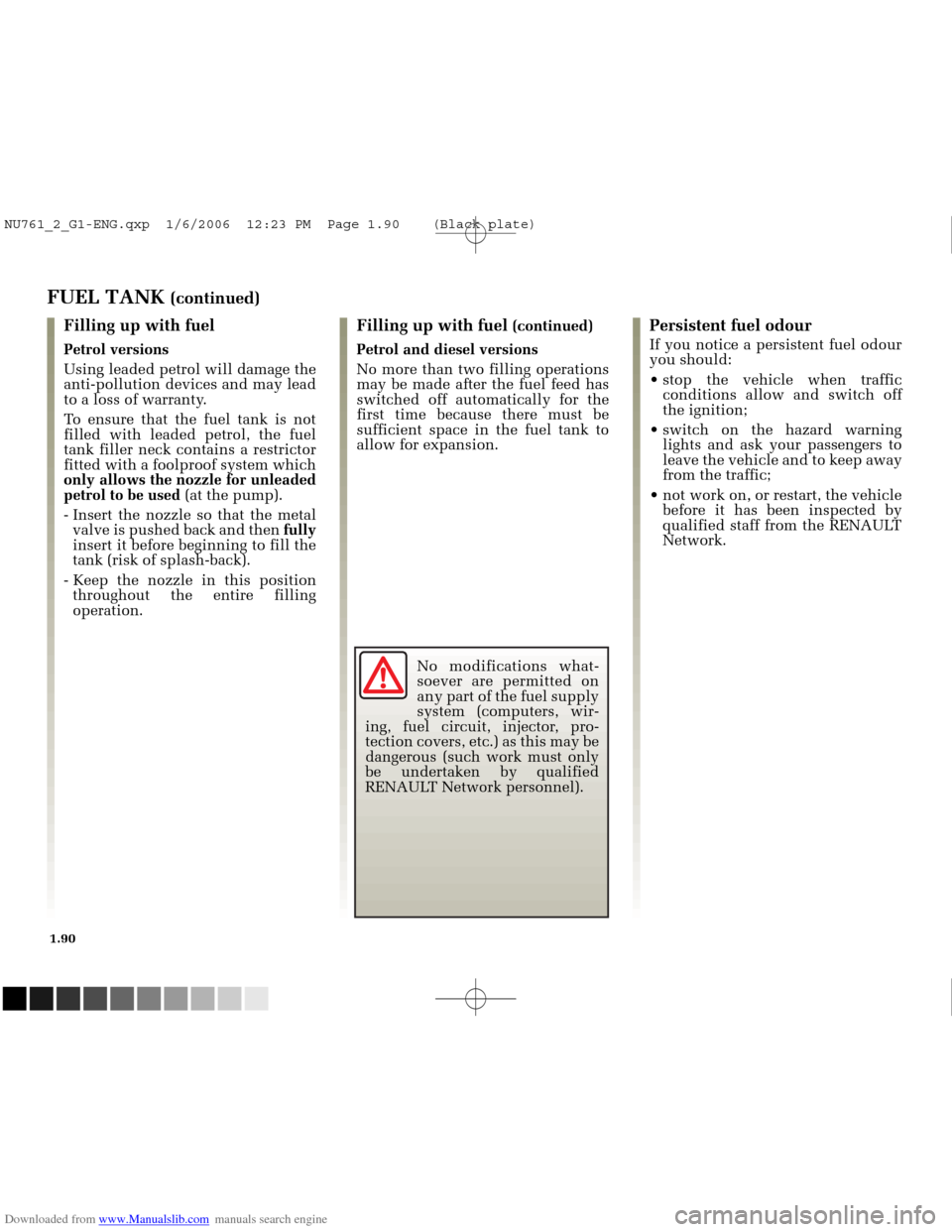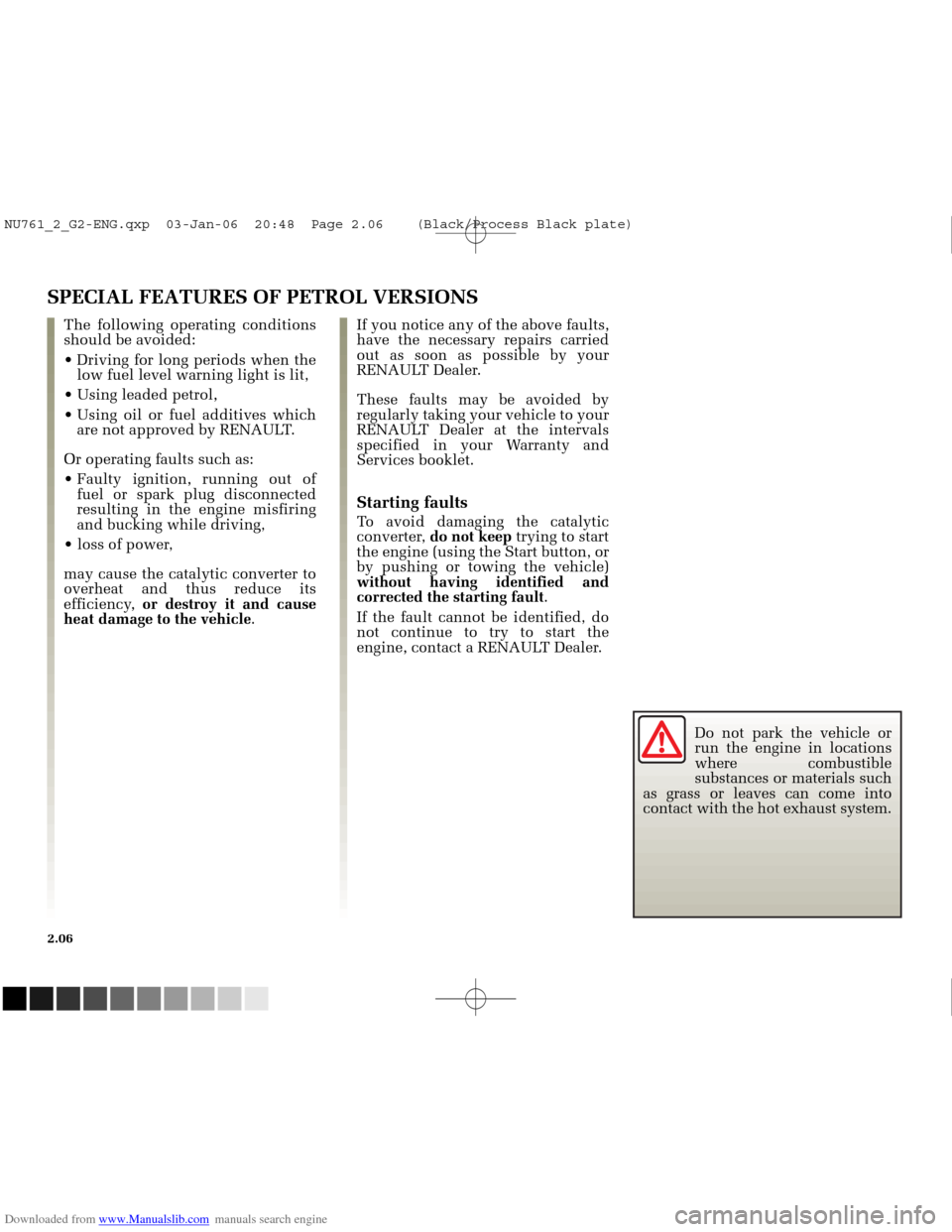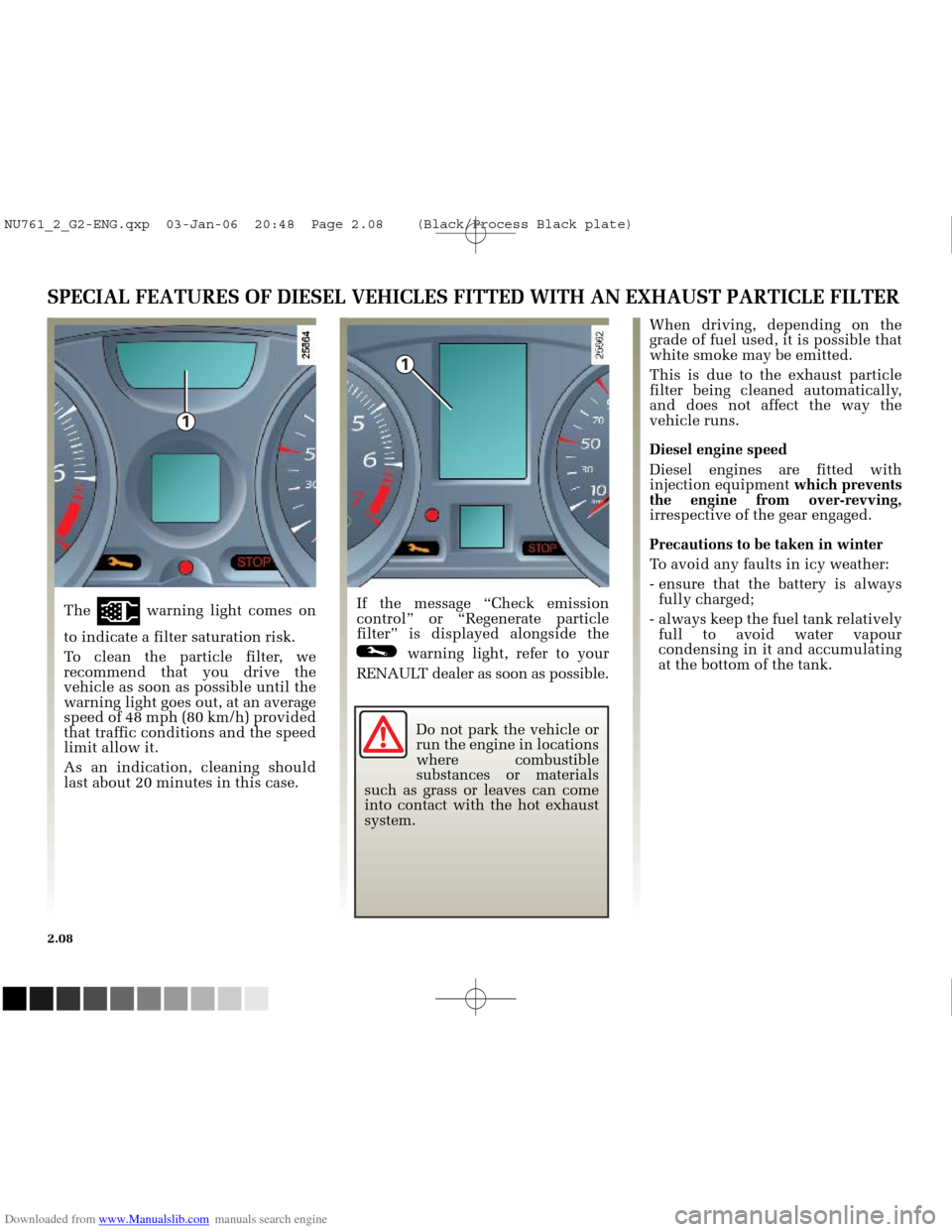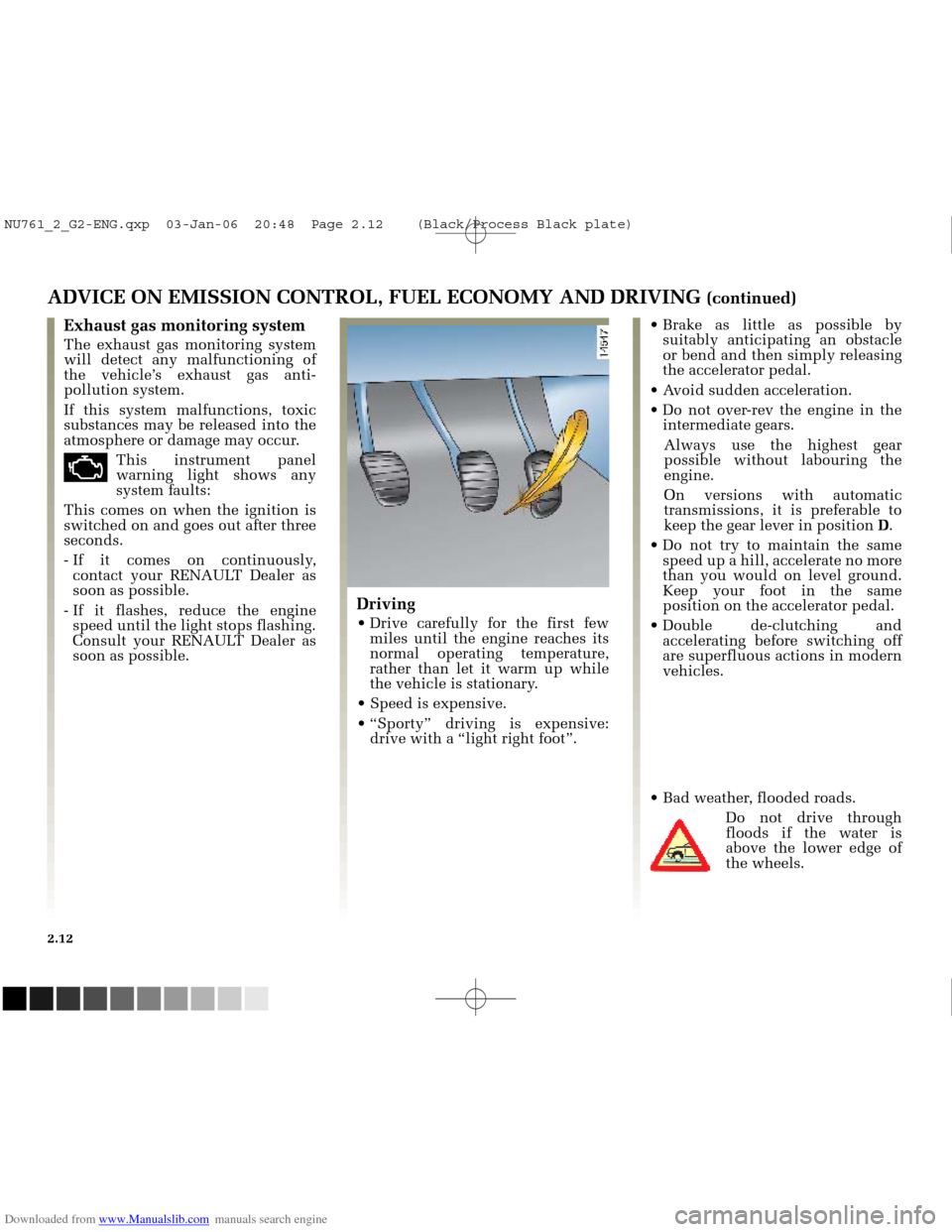2005 RENAULT MEGANE warning
[x] Cancel search: warningPage 100 of 250

Downloaded from www.Manualslib.com manuals search engine
NU761_2_G1-FRA.qxd 10/11/05 15:55 Page 1.90
1.90
No modifications what-
soever are permitted on
any part of the fuel supply
system (computers, wir-
ing, fuel circuit, injector, pro-
tection covers, etc.) as this may be
dangerous (such work must only
be undertaken by qualified
RENAULT Network personnel).
FUEL TANK (continued)
Filling up with fuel
Petrol versions
Using leaded petrol will damage the
anti-pollution devices and may lead
to a loss of warranty.
To ensure that the fuel tank is not
filled with leaded petrol, the fuel
tank filler neck contains a restrictor
fitted with a foolproof system which
only allows the nozzle for unleaded
petrol to be used (at the pump).
- Insert the nozzle so that the metal valve is pushed back and then fully
insert it before beginning to fill the
tank (risk of splash-back).
- Keep the nozzle in this position throughout the entire filling
operation.
Persistent fuel odour
If you notice a persistent fuel odour
you should:
stop the vehicle when traffic conditions allow and switch off
the ignition;
switch on the hazard warning lights and ask your passengers to
leave the vehicle and to keep away
from the traffic;
not work on, or restart, the vehicle before it has been inspected by
qualified staff from the RENAULT
Network.
Filling up with fuel (continued)
Petrol and diesel versions
No more than two filling operations
may be made after the fuel feed has
switched off automatically for the
first time because there must be
sufficient space in the fuel tank to
allow for expansion.
NU761_2_G1-ENG.qxp 1/6/2006 12:23 PM Page 1.90 (Black plate)
Page 106 of 250

Downloaded from www.Manualslib.com manuals search engine
NU761_2_G2-FRA.qxd 4/11/05 10:48 Page 2.06
2.06
SPECIAL FEATURES OF PETROL VERSIONS
If you notice any of the above faults,
have the necessary repairs carried
out as soon as possible by your
RENAULT Dealer.
These faults may be avoided by
regularly taking your vehicle to your
RENAULT Dealer at the intervals
specified in your Warranty and
Services booklet.
Starting faults
To avoid damaging the catalytic
converter, do not keep trying to start
the engine (using the Start button, or
by pushing or towing the vehicle)
without having identified and
corrected the starting fault .
If the fault cannot be identified, do
not continue to try to start the
engine, contact a RENAULT Dealer.
The following operating conditions
should be avoided:
low fuel level warning light is lit,
are not approved by RENAULT.
Or operating faults such as:
fuel or spark plug disconnected
resulting in the engine misfiring
and bucking while driving,
may cause the catalytic converter to
overheat and thus reduce its
efficiency, or destroy it and cause
heat damage to the vehicle .
Do not park the vehicle or
run the engine in locations
where combustible
substances or materials such
as grass or leaves can come into
contact with the hot exhaust system.
NU761_2_G2-ENG.qxp 03-Jan-06 20:48 Page 2.06 (Black/Process Black\
plate)
Page 108 of 250

Downloaded from www.Manualslib.com manuals search engine
1
1
NU761_2_G2-FRA.qxd 4/11/05 10:48 Page 2.08
2.08
SPECIAL FEATURES OF DIESEL VEHICLES FITTED WITH AN EXHAUST PARTICLE FILT\
ER
When driving, depending on the
grade of fuel used, it is possible that
white smoke may be emitted.
This is due to the exhaust particle
filter being cleaned automatically,
and does not affect the way the
vehicle runs.
Diesel engine speed
Diesel engines are fitted with
injection equipment which prevents
the engine from over-revving,
irrespective of the gear engaged.
Precautions to be taken in winter
To avoid any faults in icy weather:
- ensure that the battery is always fully charged;
- always keep the fuel tank relatively full to avoid water vapour
condensing in it and accumulating
at the bottom of the tank.
Do not park the vehicle or
run the engine in locations
where combustible
substances or materials
such as grass or leaves can come
into contact with the hot exhaust
system.
The warning light comes on
to indicate a filter saturation risk.
To clean the particle filter, we
recommend that you drive the
vehicle as soon as possible until the
warning light goes out, at an average
speed of 48 mph (80 km/h) provided
that traffic conditions and the speed
limit allow it.
As an indication, cleaning should
last about 20 minutes in this case.
If the message “Check emission
control” or “Regenerate particle
filter” is displayed alongside the
warning light, refer to your
RENAULT dealer as soon as possible.
NU761_2_G2-ENG.qxp 03-Jan-06 20:48 Page 2.08 (Black/Process Black\
plate)
Page 112 of 250

Downloaded from www.Manualslib.com manuals search engine
NU761_2_G2-FRA.qxd 4/11/05 10:48 Page 2.12
2.12
ADVICE ON EMISSION CONTROL, FUEL ECONOMY AND DRIVING (continued)
Driving
miles until the engine reaches its
normal operating temperature,
rather than let it warm up while
the vehicle is stationary.
drive with a “light right foot”.
Exhaust gas monitoring system
The exhaust gas monitoring system
will detect any malfunctioning of
the vehicle’s exhaust gas anti-
pollution system.
If this system malfunctions, toxic
substances may be released into the
atmosphere or damage may occur.
äThis instrument panel
warning light shows any
system faults:
This comes on when the ignition is
switched on and goes out after three
seconds.
- If it comes on continuously, contact your RENAULT Dealer as
soon as possible.
- If it flashes, reduce the engine speed until the light stops flashing.
Consult your RENAULT Dealer as
soon as possible.
suitably anticipating an obstacle
or bend and then simply releasing
the accelerator pedal.
intermediate gears.
Always use the highest gear
possible without labouring the
engine.
On versions with automatic
transmissions, it is preferable to
keep the gear lever in position D.
speed up a hill, accelerate no more
than you would on level ground.
Keep your foot in the same
position on the accelerator pedal.
accelerating before switching off
are superfluous actions in modern
vehicles.
Do not drive through
floods if the water is
above the lower edge of
the wheels.
NU761_2_G2-ENG.qxp 03-Jan-06 20:48 Page 2.12 (Black/Process Black\
plate)
Page 117 of 250

Downloaded from www.Manualslib.com manuals search engine
1
1
NU761_2_G2-FRA.qxd 4/11/05 10:48 Page 2.17
TYRE PRESSURE MONITOR (continued)
Emergency spare wheel
The spare wheel has no sensor, and
cannot be recognised by the system.
When it is fitted in the place of
another wheel, the system then
detects an operation fault.
Replacing wheels/tyres
This system requires special
equipment (wheels, wheel trims, etc.).
Contact your RENAULT Dealer to
find out about accessories
compatible with the system and
which may be purchased from
RENAULT outlets: the use of any
other accessory could affect the
correct operation of the system.
Tyre repair aerosols
Because the valves are specially
designed, use only aerosols
approved by Renault’s Technical
Department.
Display
Display 1on the instrument panel
informs you of any tyre pressure
faults (flat tyre, punctured tyre,
system fault, etc.). The following pages show the
possible warning lights, symbols
and messages.
2.17
NU761_2_G2-ENG.qxp 03-Jan-06 20:48 Page 2.17 (Black/Process Black\
plate)
Page 118 of 250

Downloaded from www.Manualslib.com manuals search engine
A
B
NU761_2_G2-FRA.qxd 4/11/05 10:48 Page 2.18
2.18
TYRE PRESSURE MONITOR (continued)Examples of messages which may appear on the display
"Check tyre pressure"
A shaded wheel B, indicates a
deflated tyre.
"Stop! Tyre puncture"
Replace the wheel affected Bor
contact a RENAULT Dealer.
This message appears along with the
ûwarning light.
"Inflate a tyre to motorway
pressure"
The tyre pressure is not suitable for
the speed of travel. Slow down or
inflate all fourtyres to motorway
pressure (refer to the tyre pressure
table).
"No tyre sensors" or "Tyre sensor
out of order"
One wheel A, disappears, indicating
that the sensor on this wheel is
missing or faulty (e.g. if the
emergency spare wheel is fitted
etc.).
NU761_2_G2-ENG.qxp 03-Jan-06 20:48 Page 2.18 (Black/Process Black\
plate)
Page 119 of 250

Downloaded from www.Manualslib.com manuals search engine
A
NU761_2_G2-FRA.qxd 4/11/05 10:48 Page 2.19
ELECTRONIC STABILITY PROGRAM: ESP WITH UNDERSTEER CONTROL
When the function begins to
operate, warning light Aflashes to
warn you.
If the warning light comes on
accompanied by the “ASR/ESP
deactivated” message when the
engine is started, slowly turn the
steering wheel from lock to lock to
reinitialise the system.
Understeer control
This system optimises the operation
of the ESP in the case of pronounced
understeering (loss of front axle
roadholding).
Operating faults
If the system detects an operating
fault, the message “Check traction
control” or “ESP/ASR not
functioning” is displayed on the
instrument panel display along with
indicator light and indicator
light A.
Contact your RENAULT Dealer.
This system helps to keep control of
the vehicle in critical driving
situations (avoiding an obstacle, loss
of grip when cornering, etc.) and
works in conjunction with the
understeer control system.
Operating principle
A sensor in the steering wheel
detects the direction selected by the
driver.
Other sensors throughout the vehicle
measure the actual direction.
The system compares the direction
selected by the driver and the actual
direction of the vehicle and corrects
this as necessary by applying the
brakes selectively and/or acting on
the engine power.
2.19
This function is an
additional aid in case of
critical driving conditions
to enable the vehicle
behaviour to be adapted to suit
the driving conditions.
However, the function does not
take the place of the driver. It
does not increase the vehicle’s
limits and should not encourage
you to drive more quickly.
Therefore, it can under no
circumstances replace the
vigilance or responsibility of the
driver when manoeuvring the
vehicle (the driver must always
be ready for sudden incidents
which may occur when driving).
NU761_2_G2-ENG.qxp 03-Jan-06 20:48 Page 2.19 (Black/Process Black\
plate)
Page 120 of 250

Downloaded from www.Manualslib.com manuals search engine
A
NU761_2_G2-FRA.qxd 4/11/05 10:48 Page 2.20
2.20
TRACTION CONTROL: ASR
Operating principle
Using the wheel sensors, the system
measures and compares the speed of
the drive wheels at all times and
slows down their over-rotation.
If a wheel is starting to spin, the
system brakes automatically until
the drive supplied becomes
compatible with the level of grip.The system also adjusts the engine
speed to the grip available under the
wheels, independently of the
pressure exerted on the accelerator
pedal.
When the function begins to
operate, warning light
Aflashes to
warn you.
This system helps to limit skidding
on drive wheels and to control the
vehicle when pulling away or
accelerating.
This function is an
additional aid in case of
critical driving conditions
to enable the vehicle
behaviour to be adapted to suit
the driving conditions.
However, the function does not
take the place of the driver. I t
does not increase the vehicle’s
limits and should not encourage
you to drive more quickly.
Therefore, it can under no
circumstances replace the
vigilance or responsibility of the
driver when manoeuvring the
vehicle (the driver must always
be ready for sudden incidents
which may occur when driving).
NU761_2_G2-ENG.qxp 03-Jan-06 20:48 Page 2.20 (Black/Process Black\
plate)